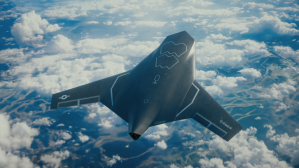After 3000.09 update, DOD stays quiet on lethal autonomous weapon reviews

Pentagon officials are operating under a seemingly de facto standard where they do not discuss when or what weapon systems have been, are, or will be subject to the freshly updated 3000.09 review process for examining and approving the deployment of lethal autonomous platforms that can engage military targets without troops intervening, DefenseScoop has learned.
The first updated version of the Defense Department’s long-standing official policy — Directive 3000.09, “Autonomy in Weapon Systems” — went into effect in January.
That revamped guiding document defines such systems as those that “once activated, can select and engage targets without further intervention by an operator.”
Outlining some exceptions, the policy broadly assigns certain senior defense officials with responsibilities around overseeing the development, procurement, testing, fielding and ultimate use of autonomous weapons. It also directs the Pentagon to set up a new working group of officials charged with heading senior-level reviews of these still-emerging technologies.
In responses to multiple questions from DefenseScoop over recent months regarding how DOD is executing on this refreshed 3000.09 review and whether any autonomous systems have been approved for use by the U.S. military, Pentagon officials have emphasized the department’s intent to operate in a trustworthy manner — but repeatedly declined to share any information about specific weapons in the context of the review process.
“DOD’s policy [for] autonomy in weapon systems, Directive 3000.09, is designed to ensure that, if DOD needs to develop and field autonomous weapon systems, it can do so safely, responsibly, and in accordance with the law. DOD is always evaluating potential systems to see what kind of reviews are required prior to their development and fielding, including but not limited to the review process in DOD Directive 3000.09. We cannot comment on the DOD Directive 3000.09 review process with regard to any particular weapon system, however,” a Pentagon spokesperson told DefenseScoop via email in September.
Earlier this summer, responding to questions from DefenseScoop at a tech summit, Michael Horowitz, director of the Pentagon’s emerging capabilities policy office, struck a similar tone.
Noting that one new element of the latest version of 3000.09 is the creation of that “autonomous weapon system working group that’s designed to be essentially a clearing house in the department” for people “who have questions about systems they’re developing and want to understand whether they would fall under the review process,” Horowitz confirmed that “there are lots of conversations that are always going on about different systems” that folks across DOD components may aim to apply or develop.
“[But] we can’t comment on any particular weapon systems,” he said.
At a separate defense technology conference, later on in August, a senior DOD expert focusing on autonomy and artificial intelligence told DefenseScoop: “We have started that [3000.09] process. I don’t know how much I could talk about that there — because it’s not unclassified. But I will say that the rigor that’s laid out in the new version that you’ve seen is being put into practice.”
These and other comments do not echo answers DOD officials have provided to questions about what’s undergoing the review process prior to the 3000.09 update. In March 2019, for instance, a Pentagon spokesperson stated that “no weapon has been required to undergo the Senior Review in accordance with DOD Directive 3000.09” up to that point.
The remarks also come at a time when the U.S. military is moving to deploy AI, unmanned platforms and other capabilities that could result in weapon systems with much more autonomy in conflict zones in the years to come.
Deputy Defense Secretary Kathleen Hicks (who notably signed off on the 3000.09 update) recently launched the new Replicator initiative to enable attritable drones to be fielded by the U.S. military at a scale of multiple thousands in multiple domains within the next two years.
Though Hicks has clarified that systems associated with Replicator are “not synonymous” with autonomous weapon systems, she has also emphasized that the department has been integrating them into pursuits “for decades, from Aegis destroyers to ship- and ground-based Phalanx defense systems” — and that the military has “continually gotten better at it.”
DefenseScoop recently asked the Pentagon spokesperson again whether any autonomous weapon systems have been assessed and if it is DOD’s official policy not to comment on or confirm whether existing or envisioned capabilities have or will be put through the review.
“As noted previously, we cannot comment on the DOD Directive 3000.09 review process with regard to any particular weapon system. I do not have anything to add regarding systems that have gone through or are currently going through the 3000.09 review process,” the official said.
They did not share explicit reasons for why the Pentagon is declining to comment at all on the matter.
Editor’s note: Jon Harper contributed to this article.






